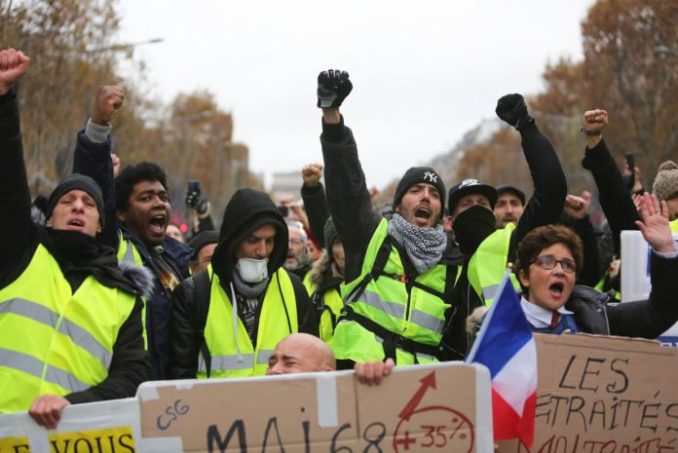Yellow Vests’ anger turns to rage

Bulletin, Dec. 4 — The French government has conceded on the original main demand of the Yellow Vest movement and suspended the tax hike on gasoline. The movement says it will continue to press its other demands.
Dec. 2 — For the third weekend in a row, tens of thousands of people in France have taken to the streets in hundreds of demonstrations that ranged from a near insurrection in Paris to occupying airport runways and toll plazas; blocking traffic circles, roads, malls and creating traffic jams; and having a huge but unmeasurable effect on France’s economy.
The government said that 136,000 people protested on Dec. 1. That figure is probably low, given that these “Yellow Vests” — named for the high-visibility vests that all French autos are required to carry in case of an emergency — were protesting a big tax increase that the government was going to impose on fuel for cars.
Beyond Paris, clashes between Yellow Vests and cops took place in Dijon, Bordeaux, Toulouse and Marseille. Confrontations took place even in small towns like Puy-en-Velay, southwest of Lyon. When the Yellow Vests were refused permission to talk to the prefecture, the central government’s representative in the area, they set fire to his office and several others nearby and blocked fire trucks.
In Toulouse, Yellow Vests joined up with railroad workers organized by the labor federation CGT. Both groups confronted the cops for three hours in the center city near the railroad station.
In Paris, confrontations begun in the morning lasted well into the night. The cops used tear gas — so much that when a police platoon was set to clear an intersection, it had to be issued an additional equipment: water cannons. The protesters replied with stones they had crowbarred out of the street pavement, as well as sticks, Molotov cocktails and general debris.
Beyond occupying the Arc de Triomphe — the monument to heroes of the French Revolution and Napoleonic wars, which also contains the Tomb of the Unknown Soldier — protesters also attacked banks, the former stock exchange and high-end stores selling luxury goods and cars.
What disturbed the French government greatly was graffiti on the Arc saying “Macron resign” and “The Yellow Vests will triumph!” French President Emmanuel Macron, speaking at a press conference in Buenos Aires, Argentina, brought up this graffiti in response to a question about the situation in France.
Broad public support
Since a huge majority of the French support the aims of the Yellow Vests — public opinion polls said 75 to 85 percent — the identity of the forces engaged in attacking and looting the high-end clothing and liquor stores is a subject of great interest. Are the “casseurs” — the French word for people who attack stores and banks during demonstrations — from the ultra-right, the ultra-left or anarchists? Or might they be provocateurs working for the government?
One video on the internet showed plainclothes cops putting on Yellow Vests and participating in the revolt.
The French media on Dec. 2 were filled with stories about cars that were burned, along with some of the world’s fanciest stores being looted down to bare shelves. Prime Minister Édouard Philippe is trying to set up a meeting with seven Yellow Vests to begin a dialogue. At a previous meeting, one of the Yellow Vests he invited walked out when Philippe wouldn’t let him livestream.
The Yellow Vests are a mass movement organized basically on Facebook. Many of the people who have come out haven’t demonstrated before, but are having increasing problems making ends meet. Their growing anger is turning into rage, especially since the government has hardly budged on their demands, which have evolved from lowering taxes to increasing the minimum wage and improving pensions.
It is clear that Philippe is playing the “good” cop while letting Macron and his interior minister play the “tough” one. It’s not likely that this tactic will work. Macron is going to have to make concessions or up the ante and impose a state of emergency.

